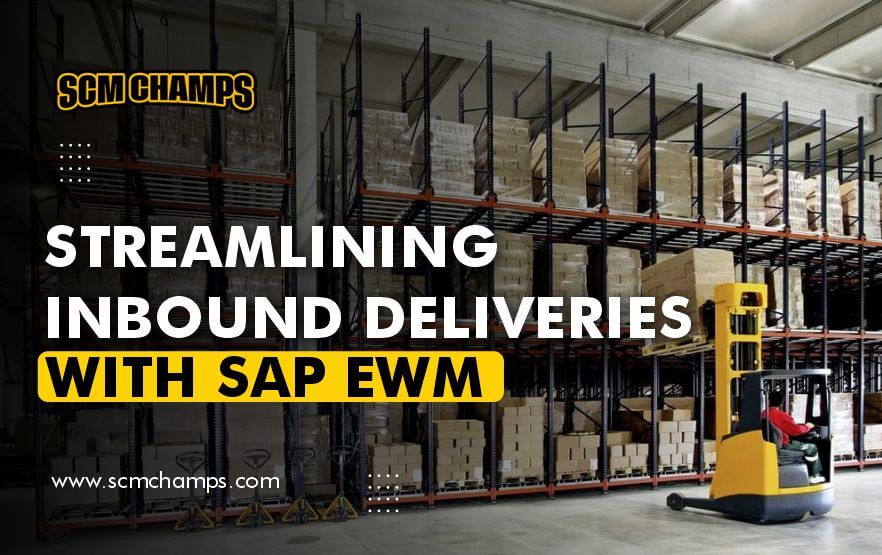
Introduction:
Processing inbound deliveries efficiently is crucial for any business. SAP Extended Warehouse Management (SAP EWM) and SAP ERP offer an array of features to help you manage, update, and validate delivery-related data seamlessly. In this article, we will explore the key functions and integration processes to enhance your inbound delivery operations.
Important Key Functions and Integration Process for Delivery Operations
1. Integration Simplified:
In the realm of seamless data exchange between SAP Extended Warehouse Management (EWM) and SAP ERP, “Integration Simplified” is the key. This pointer invites you to unravel the intricacies of the integration process, shedding light on the inner workings of how these systems harmoniously communicate. By understanding this integration, you can harness its full potential to optimize your supply chain operations, making them more efficient and productive.
2. Prerequisite Essentials:
Before diving headfirst into any venture, it’s essential to grasp the prerequisites. “Prerequisite Essentials” ensures you are well-versed in the fundamental requirements for establishing effective communication between SAP EWM and SAP ERP. It’s akin to laying a strong foundation for a building – ensuring that your systems are primed for successful data exchange.
3. Customizing for Enhanced Integration:
Just as a tailor customizes a suit to fit perfectly, “Customizing for Enhanced Integration” allows you to fine-tune the integration between SAP EWM and SAP ERP to your specific needs. This entails navigating through the intricacies of system configuration. The aim here is to make this integration work harmoniously with your unique business processes, unlocking its full potential.
4. Effortless Inbound Delivery Notification:
When it comes to receiving notifications about inbound deliveries, “Effortless Inbound Delivery Notification” is the way forward. This facet of SAP EWM lets you effortlessly receive, validate, and process notifications. You’ll discover how SAP EWM manages errors within advanced shipping notifications from SAP ERP, ensuring a smoother and error-free inbound delivery process.
5. Handling Unit Data in SAP EWM:
Delving into the realm of “Handling Unit Data in SAP EWM” sheds light on the crucial significance of effectively managing handling unit data (HU data) within inbound delivery notifications. It presents an invaluable chance to grasp the distinguishing factor of SAP EWM, which lies in its provision of automatic packing—an exceptional attribute absent in SAP ERP. This remarkable capability seamlessly streamlines and elevates the efficiency of handling your merchandise, revolutionizing the way goods are managed and processed.
6. Managing Change Requests:
In the dynamic world of supply chain management, “Managing Change Requests” is a vital aspect. This pointer delves into how vendors can initiate changes through advanced shipping notifications or rejections for existing inbound deliveries. SAP EWM plays a pivotal role in processing these requests efficiently and effectively communicating with SAP ERP.
7. Manual Inbound Delivery Receipt:
Sometimes, a more hands-on approach is needed. “Manual Inbound Delivery Receipt” explores the alternative of manually creating inbound deliveries within SAP EWM. You’ll learn how to input data manually or utilize reference documents, resulting in a swift and efficient processing method tailored to your specific requirements.
8. Proactive Data Updates:
“Proactive Data Updates” showcase SAP EWM’s ability to alert SAP ERP about modifications even before the goods receipt confirmation. This detail provides insights into the types of data conveyed and sheds light on how it shapes the entire process. Essentially, it’s all about being proactive, staying one step ahead in adapting to alterations, and maintaining a smooth information flow.
9. Efficient Goods Receipt Confirmation:
In the realm of goods receipt, efficiency is key. This pointer unveils the various options available in SAP EWM for confirming goods receipt. Whether partial or complete goods receipt postings and the decision to transfer handling unit (HU) data to SAP ERP, it offers insights into optimizing this vital process.
10. Correcting or Reversing Goods Receipts:
Mistakes happen, and “Correcting or Reversing Goods Receipts” is your guide to addressing them effectively. You’ll discover how SAP EWM simplifies the correction or reversal of goods movement postings. The creation of material documents plays a crucial role in notifying SAP ERP about corrections or cancellations.
11. Inbound Delivery Splitting:
In the world of complex inbound deliveries, sometimes it’s necessary to split them into manageable parts. “Inbound Delivery Splitting” unveils the process of effectively splitting inbound deliveries within SAP EWM. It provides insights into the generation of new inbound deliveries, all while ensuring that number range intervals are well-defined, ensuring a smooth and organized process.
Conclusion by SCM Champs:
Efficiently managing inbound deliveries is imperative for SCM Champs‘ streamlined operations. The seamless integration of SAP EWM and SAP ERP equips you with a robust toolkit and streamlined processes, ensuring your inbound delivery management is efficient and error-free. Delve into the highlighted features and integrations within this article to optimize your inbound delivery processes, driving increased efficiency and precision in your supply chain operations.
Read also: Key Functions of SAP EWM


